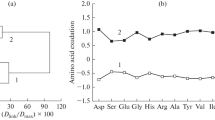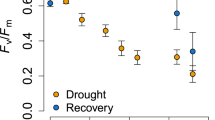Abstract
Seven sorghum accessions were evaluated quantitatively and qualitatively for the composition of their root exudates. Utilizing a unique capillary mat growing system, root exudates were collected from all sorghum accessions. Exudates were subjected to TLC and HPLC analysis to evaluate their chemical composition. Within each sorghum accession, variation existed in the amount of exudate produced and the chemical constituents of each exudate. Sorgoleone was the predominant constituent identified in each accession's exudate. Other closely related compounds, including 5-ethoxysorgoleone, 2,5-dimethoxysorgoleone, three other minor components (MW = 364, 388, and 402), and one unidentified component comprised the minor constituents of the root exudate. Our past work has shown that several of these compounds have potent phytotoxic activity as photosystem II inhibitors, thereby lending further support to the concept that Sorghum spp. are allelopathic and weed suppressive.
Similar content being viewed by others
References
Abdul-Wahab, A. S. and Rice, E. 1967. Plant inhibition by johnsongrass and its possible significance in old-field succession. Bull. Torrey Bot. Club 94:486–497.
Bar-Yosef, B. 1996. Root excretions and their environmental effects: Influence on availability of phosphorus, pp. 581–605, in Y. Waisel, A. Eshel, and U. Kafkafi (Eds.). Plant Roots. The Hidden Half: Marcel Dekker, New York.
Chang, M., Netzly, D., Butler, L. G., and Lynn, D. G. 1986. Chemical regulation of distance: Characterization of the first natural host germination stimulant for Striga asiatica. J. Am. Chem. Soc. 108:7858–7860.
Duke, S. O., Scheffler, B. E., Dayan, F. E., Weston, L. A., and Ota, E. 2001. Strategies for using transgenes to produce allelopathic crops. Weed Tech. 15:826–834.
Einhelllig, F. A. and Rasmussen, J. A. 1989. Prior cropping with grain sorghum inhibits weeds. J. Chem. Ecol. 15:951–960.
Einhelllig, F. A., Rasmussen, J. A., Hejl, A. M., and Souza, I. F. 1993. Effects of root exudate sorgoleone on photosynthesis. J. Chem. Ecol. 19:369–375.
Einhelllig, F. A. and Souza, I. F. 1992. Phytotoxicity of sorgoleone found in grain sorghum root exudates. J. Chem. Ecol. 18:1–11.
Fate, G., Chang, M., and Lynn, D. G. 1990. Control of germination in Striga asiatica: Chemistry of spatial definition. Plant Physiol. 93:201–207.
Forney, D. R., Foy, C. L., and Wolf, D. D. 1985. Weed suppression in no-till alfalfa (Medicago sativa) by prior cropping of summer-annual forage grasses. Weed Sci. 33:490–497.
Geneve, R. L. and Weston, L. A. 1988. Growth reduction of eastern redbud (Cercis canadensis L.) seedling caused by interaction with a sorghum-sudangrass hybrid (sudex). J. Environ. Hort. 6:24–26.
Gonzalez, V. M., Kazimir, J., Nimbal, C. I., Weston, L. A., and Cheniae, G. M. 1997. Inhibition of a photosystem II electron transfer reaction by the natural product sorgoleone. J. Agric. Food Chem. 45:1415–1421.
Guenzi, W. D. and Mccalla, I. N. 1966. Phenolic acids in oats, wheat, sorghum and corn residues and their phytotoxicity. Agronomy J. 58:303–304.
Guneyli, E., Burnside, O. C., and Nordquist, P. T. 1969. Influence of seedling characteristics on weed competitive ability of sorghum hybrids and inbred lines. Crop Sci. 9:713–716.
Henry, A. 2000. A study on the responses of rhizosphere bacteria to sorgoleone and allelopathic root exudates. Unpublished Plant Science Honors Thesis, Cornell University, Ithaca, New York.
Holm, L. G., Plunknett, D. L., Pancho, J. V., and Herberger, J. P. 1991. The World's Worst Weeds. Distribution and Biology. Krieger Publishing, Malabar, Florida, 609 p.
Marschner, H. and Romheld, V. 1996. Root-induced changes in the availability of micronutrients in the rhizosphere, pp. 557–579, in Y. Waisel, A. Eshel, and U. Kafkafi (Eds.). Plant Roots. The Hidden Half. Marcel Dekker, New York.
Netzly, D. H. and Butler, L. G. 1986. Roots of sorghum exude hydrophobic droplets containing biologically active components. Crop Sci. 26:775–777.
Nimbal, C. I., Pedersen, J. F., Yerkes, C. N., Weston, L. A., and Weller, S. C. 1996a. Phytotoxicity and distribution of sorgoleone in grain sorghum germplasm. J. Agric. Food Chem. 44:1343–1347.
Nimbal, C. I., Yerkes, C. N., Weston, L. A., and Weller, S. C. 1996b. Herbicidal activity and site of action of the natural product sorgoleone. Pestic. Biochem. Physiol. 54:73–83.
Rimando, A. M., Czarnota, M. A., and Weston, L. A. 2001. Analysis of root exudates of seven sorghum accessions. Abstracts of Papers, 222nd ACS National Meeting, Chicago, Illinois, Aug. 26–30, 2001, AGFD-060.
Rimando, A. M., Dayan, F. E., Czarnota, M. A., Weston, L. A., and Duke, S. O. 1998. A new photosystem II electron transfer inhibitor from Sorghum bicolor. J. Nat. Prod. 61:927–930.
Rimando, A. M., Dayan, F. E., and Streibig, J. C. 2003. PSII inhibitory activity of resorcinolic lipids from Sorghum bicolor. J. Nat. Prod. 66:42–45.
Weston, L. A. 1996. Utilization of allelopathy for weed management in agroecosystems. Agron. J. 88:860–866.
Weston, L. A., Harmon, R., and Mueller, S. 1989. Allelopathic potential of sorghum-sudangrass hybrid (Sudex). J. Chem. Ecol. 15:1855–1865.
Author information
Authors and Affiliations
Corresponding author
Rights and permissions
About this article
Cite this article
Czarnota, M.A., Rimando, A.M. & Weston, L.A. Evaluation of Root Exudates of Seven Sorghum Accessions. J Chem Ecol 29, 2073–2083 (2003). https://doi.org/10.1023/A:1025634402071
Issue Date:
DOI: https://doi.org/10.1023/A:1025634402071




